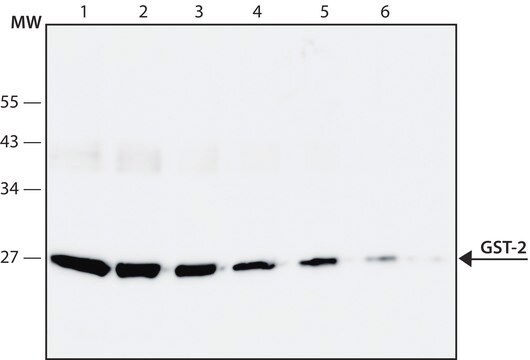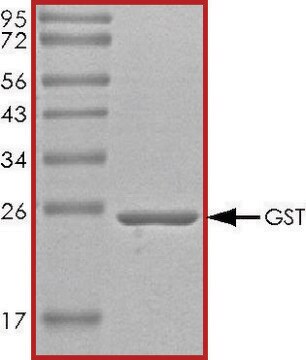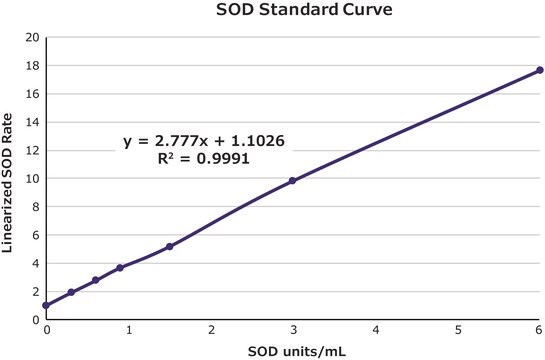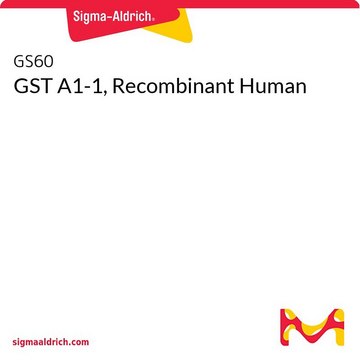CS0410
Glutathione-S-Transferase (GST) Assay Kit
sufficient for 500 multiwell tests
Synonym(s):
GST Enzyme Activity Kit
Sign Into View Organizational & Contract Pricing
All Photos(2)
About This Item
Recommended Products
usage
sufficient for 500 multiwell tests
Quality Level
shipped in
dry ice
storage temp.
−20°C
Gene Information
human ... GSTA4(2941) , GSTM1(2944)
General description
The Glutathione S-Transferase (GST) Assay Kit is designed to measure total GSTactivity. It can be used to measure GST activity in cell and bacterial lysates, tissue homogenates, and in plasma
and erythrocyte lysates
and erythrocyte lysates
Application
The Glutathione S-Transferase Assay kit utilizes 1-Chloro-2,4-dinitrobenzene (CDNB), which is suitable for the broadest range of GST isozymes. Upon conjugation of the thiol group of glutathione to the CDNB substrate, there is an increase in the absorbance at 340 nm.
Biochem/physiol Actions
Glutathione S-transferases (GSTs) are a group of enzymes important in the detoxification of many xenobiotics in mammals. The enzymes protect cells against toxicants by conjugating the thiol group of the glutathione to electrophilic xenobiotics, and thereby defend cells against the mutagenic, carcinogenic, and toxic effects of the compounds. GST activity is present in plants, insects, yeast, bacteria, and most mammalian tissues especially in the liver, which plays a key role in detoxification.
Kit Components Only
Product No.
Description
- Dulbecco's Phosphate Buffered Saline 100 mL
- L-Glutathione Reduced 1 g
- GST (Control) .1 mL
- Sample Buffer 5 mL
- Substrate (CDNB) 1.2 mL
Signal Word
Danger
Hazard Statements
Precautionary Statements
Hazard Classifications
Acute Tox. 2 Dermal - Acute Tox. 4 Oral - Aquatic Acute 1 - Aquatic Chronic 1 - Eye Dam. 1 - Skin Irrit. 2 - Skin Sens. 1
Storage Class Code
6.1A - Combustible acute toxic Cat. 1 and 2 / very toxic hazardous materials
Flash Point(F)
Not applicable
Flash Point(C)
Not applicable
Choose from one of the most recent versions:
Already Own This Product?
Find documentation for the products that you have recently purchased in the Document Library.
Customers Also Viewed
Maria Sehlstedt et al.
Particle and fibre toxicology, 7, 21-21 (2010-08-24)
Biomass combustion contributes to the production of ambient particulate matter (PM) in rural environments as well as urban settings, but relatively little is known about the health effects of these emissions. The aim of this study was therefore to characterize
Irvin Bonola-Gallardo et al.
Biological trace element research, 176(1), 40-47 (2016-07-28)
This study was conducted to measure the activity of the enzyme glutathione S-transferase (GST) in saliva and to compare the activity of this enzyme in children with and without dental fluorosis in communities with different concentrations of naturally fluoridated water.
Didier Techer et al.
Environmental toxicology, 32(1), 227-240 (2015-12-18)
Gallic and pelargonic acids are biologically derived substances receiving a growing interest as eco-friendly biocides with potential applications in freshwater system management. However, some data gaps remain to address their chronic ecotoxicity issue, particularly for fish. This work aimed at
T Lin et al.
Toxicology, 235(1-2), 1-10 (2007-04-10)
Glutathione (GSH) is one of the most important antioxidants in mammalian cells. It also plays an important role in chemical detoxification. Some evidence showed that polycyclic aromatic hydrocarbons, such as benzo[a]pyrene (B[a]P [50-32-8]), could increase GSH content as a defense
Daniel Scotcher et al.
Drug metabolism and disposition: the biological fate of chemicals, 45(5), 556-568 (2017-03-09)
In vitro-in vivo extrapolation of drug metabolism data obtained in enriched preparations of subcellular fractions rely on robust estimates of physiologically relevant scaling factors for the prediction of clearance in vivo. The purpose of the current study was to measure
Our team of scientists has experience in all areas of research including Life Science, Material Science, Chemical Synthesis, Chromatography, Analytical and many others.
Contact Technical Service









